Zero-emission B-Class sets off on automotive marathon around the World
Content provided by BenzInsider.com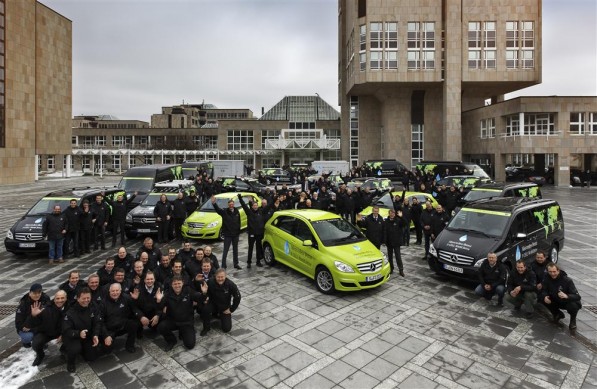
As part of the ceremony to mark the 125th birthday of the invention of the motor car on 29 January in Stuttgart, German Chancellor Dr. Angela Merkel and Dr. Dieter Zetsche, Chairman of the Board of Management of Daimler AG, fired the symbolic starting shot for the Mercedes-Benz F-CELL World Drive. Setting out from Stuttgart on 30 January, three Mercedes-Benz B-Class vehicles featuring local zero-emission fuel cell drives are undertaking a 125-day circumnavigation of the world. Travelling across four continents and through 14 countries, the three B-Class F-CELL vehicles will head around the globe once, finishing their “world tour” back in Stuttgart where they started. With the F-CELL World Drive, Mercedes-Benz is aiming to confirm the technical maturity of fuel cell technology, as well as the suitability for everyday use of the vehicles. At the same time, the company will also take the opportunity to enforce the political call to establish a comprehensive filling station infrastructure for fuel cell vehicles.

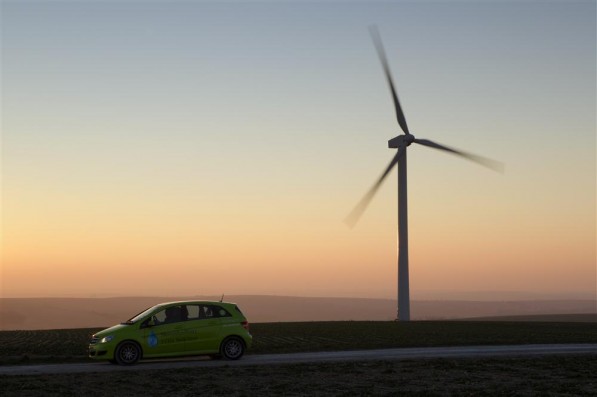
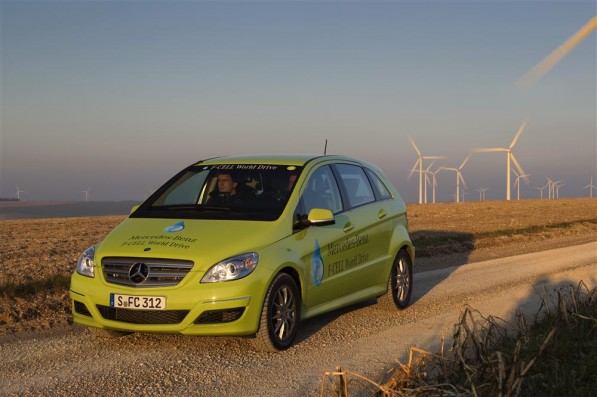

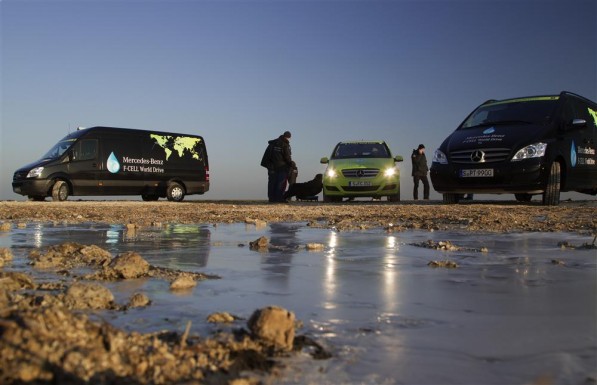
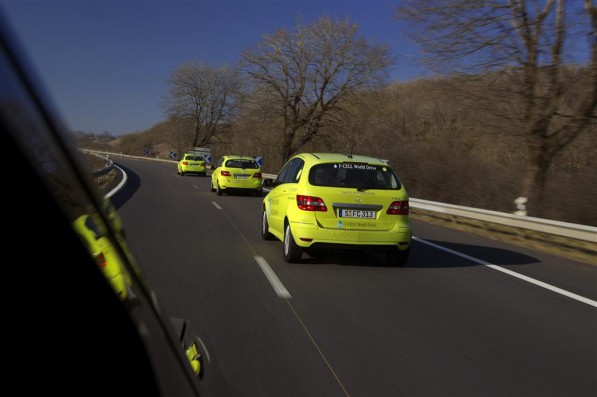
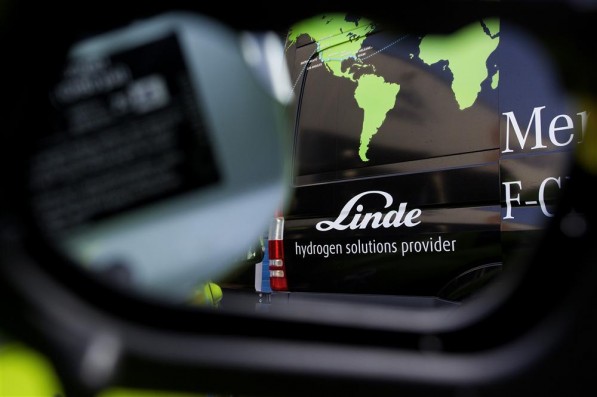
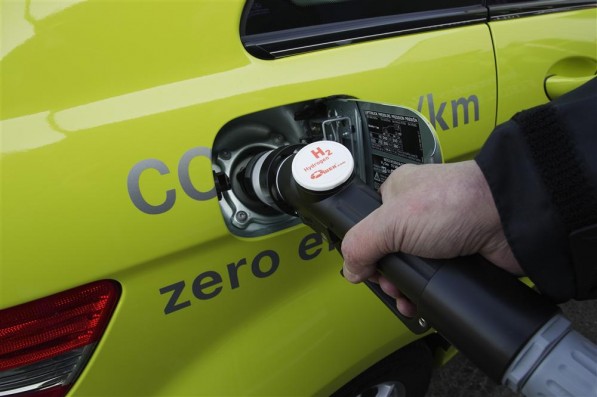
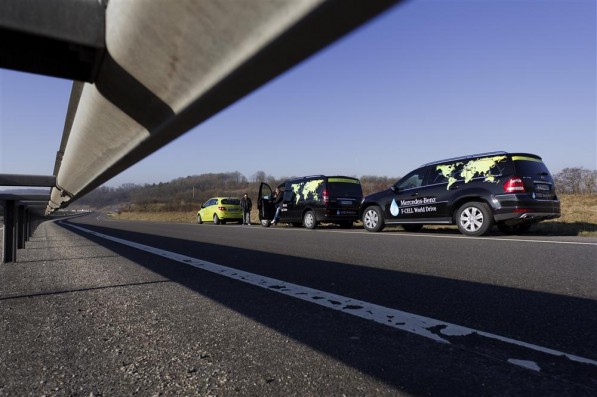
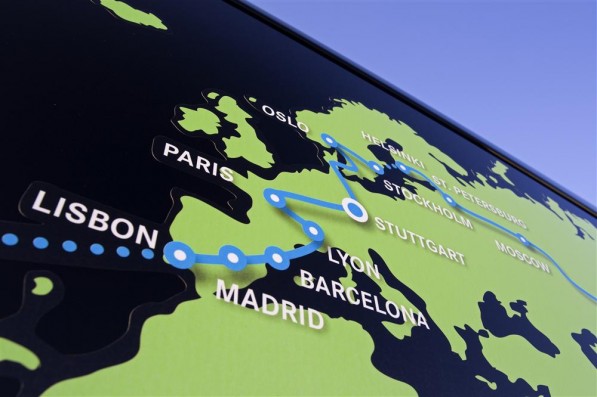

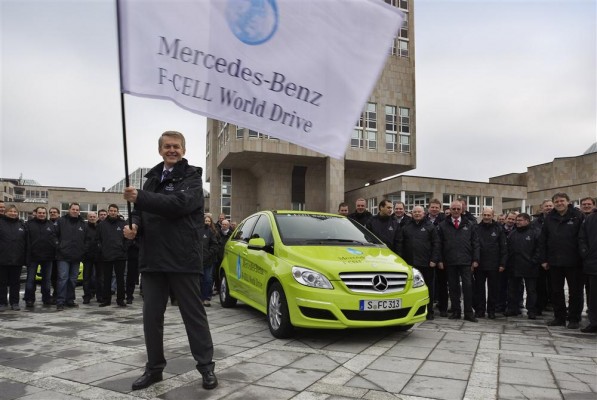

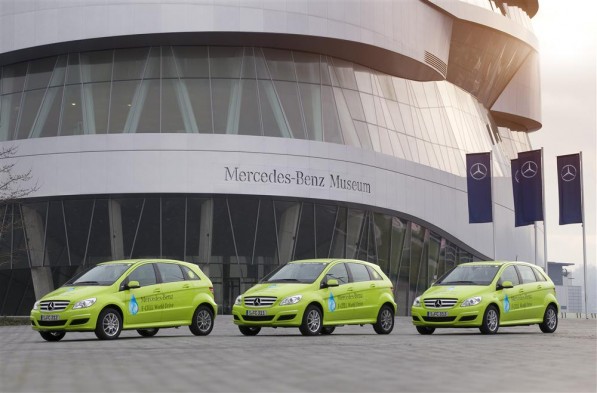
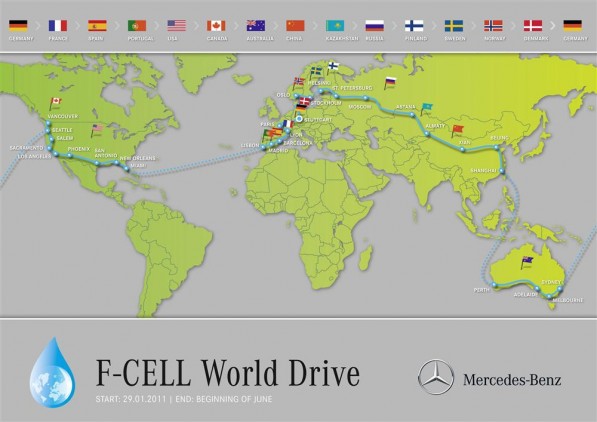
On January 29, 1886, Carl Benz filed the patent for his three-wheeled
“vehicle with gas engine operation” under number 37435, thus setting the
first milestone for a completely new form of mobility. Some 125 years
to the day later – on 29 January 2011 – Daimler AG is taking this date
as an opportunity not only to look back through history and highlight
the milestones of automotive development, but also to give a specific
insight into the future of mobility. The symbolic start of the F-CELL
World Drive, the first circumnavigation of world using
standard-production fuel cell vehicles, therefore also took place as
part of the celebrations. After the three Mercedes-Benz B-Class F-CELL
vehicles – which are starting their long journey on January 30 – were
driven onto the stage by Mercedes-Benz racing drivers Michael
Schumacher, Nico Rosberg and David Coulthard, the symbolic starting shot
was fired by Dr. Dieter Zetsche, Chairman of the Board of Daimler AG,
together with German Chancellor Dr. Angela Merkel.
Over a route covering 30,000 kilometres, the three Mercedes-Benz
B-Class F-CELL vehicles will demonstrate that they are a safe and
reliable means of transport over long distances and in the widest
variety of road and weather conditions. “Some 125 years after the
invention of the motor car, for us the B-Class F-CELL embodies its
reinvention”, explains Dr. Dieter Zetsche, Chairman of the Board of
Management of Daimler AG, commenting on the significance of the
innovative fuel cell vehicle. “As an event which is currently unique,
this circumnavigation of the world in customer-ready fuel cell vehicles
again demonstrates that we have sufficient pioneering spirit for at
least another 125 years of innovation.”
On the road with the fuel cell – mobility with zero emissions and no compromises
Electric vehicles with fuel cell combine the benefits of a long range
with a short refuelling time. As a result they are able to make a
contribution towards local zero-emission mobility not only in densely
populated areas, but also over long-distance routes. In addition,
besides their use in passenger cars, fuel cell drives can also be used
in a variety of other vehicle types, such as urban buses for example.
Mercedes-Benz recognised this potential at an early stage, launching the
first vehicle with fuel cell drive, the NECAR 1, as early as 1994.
Since that time, the company has made very significant progress in the
development of this technology, enabling it in the meantime to reach a
very high level of technical maturity. As a result, for the first time
all of the development and production standards applicable to series
production vehicles have now also been applied to the B-Class F-CELL.
All of the F-CELL components comply with the highest of Mercedes-Benz
standards in terms of their quality, reliability and service life.
Besides local zero-emission mobility, the B-Class F-CELL also
provides all of the brand-typical characteristics, such as safety,
comfort, superior performance and also exemplary functionality, in
combination with complete suitability for everyday use and unrestricted
driving pleasure.
With the F-CELL World Drive, Mercedes-Benz wants to prove the high
degree of maturity which has been achieved with fuel cell technology and
also highlight its potential on a global basis. At the same time the
circumnavigation of the world will also draw attention to a significant
challenge: the infrastructure for the provision of hydrogen. “This type
of electric mobility can only be implemented on a comprehensive scale
when it is backed by a network of hydrogen filling stations designed to
meet demand. This filling station network now has to be developed by
joining forces,” explains Dr. Thomas Weber, Daimler AG Board Member
responsible for Group Research and Development, Mercedes-Benz Cars. “We
have done our homework: the B-Class F-CELL shows to impressive effect
the contribution which electric vehicles with fuel cell are already able
to make to future mobility. The vehicle enables local zero-emission
motoring not only over short routes but also over longer distances. We
will demonstrate this with our F-CELL World Drive,” confirms Dr. Thomas
Weber.
4 continents, 14 countries and 30,000 kilometres in 125 days
Setting off from Stuttgart on January 30, the tour will initially
head south via Paris, Barcelona and Madrid, to the Portuguese capital of
Lisbon. There the cars will leave European soil and continue their
journey by plane to the East Coast of the USA.
From Fort Lauderdale, Florida, the route heads across the North
American continent, along the Gulf of Mexico, leading westwards to Los
Angeles, California. Then, travelling along the west coast of the USA,
the F-CELL World Drive will go north, finally reaching Vancouver,
Canada. After driving for roughly one month and covering more than 7500
kilometres, the vehicles will leave North America, in order to continue
their tour in the east of Australia. Starting in Sydney, the B-Class
F-CELL vehicles will head along the south coast of the fifth continent,
covering more than 5000 kilometres, with stopovers in Melbourne and
Adelaide, until reaching Perth. The last transfer between continents on
the world tour will finally take the F-CELL World Drive to the continent
of Asia, to the destination of Shanghai in China.
Travelling via the Chinese capital of Beijing, the fuel cell cars
will cover a distance of more than 10,000 kilometres across the
continent of Eurasia, heading through the Kazakh cities of Almaty and
Astana, to Moscow. This is a stretch of the route with which
Mercedes-Benz is already very familiar. In 2006 no less than 33
Mercedes-Benz E-Class vehicles passed through this region, in the
opposite direction from Paris to Beijing, as part of the “E-Class
Experience”.
On the last stage, the route will head through Northern Europe. From
St. Petersburg in Russia, the cars will travel via Finland to the
Swedish capital of Stockholm. Oslo in Norway is another destination on
the route, before the F-CELL World Drive takes the vehicles via Denmark
and back to Germany again, where they will make stopovers in such cities
as Hamburg. After 70 days of driving on a journey lasting 125 days, the
tour will finally come to an end, back in Stuttgart again, at the
beginning of June.
More than 20 stopovers
During the F-CELL World Drive, Mercedes-Benz will not only be
demonstrating the performance of its vehicles, but at the same time will
also make use of the tour to increase global awareness of the potential
of fuel cell technology. Local activities providing an opportunity for
an intensive exchange of information on the topic of electric mobility
will take place on more than 20 days at several locations along the
route. The programme will also incorporate politics and partners of the
Stuttgart-based automotive manufacturer.
The participants of the tour will therefore pay a visit to the car2go
mobility project in Austin, Texas, among others. Austin was the first
location for the innovative mobility concept outside of Europe, and the
project continues to be extremely successful there. A few days later,
the participants will visit the Automotive Fuel Cell Cooperation in
Vancouver, Canada. This is where the fuel cell stacks used in the
B-Class F-CELL, for example, were developed. The company was established
in 2007 with Daimler as the majority shareholder (50.1 percent). The
other partners are the Ford Motor Company (30 percent) and Ballard Power
Systems (19.9 percent). Furthermore, participants on the Vancouver leg
of the tour in Canada will also have the opportunity to meet the
adventurer and explorer Mike Horn and experience his PANGAEA Expedition –
for which Mercedes-Benz is the main sponsor – first hand. Since October
2008, The PANGAEA Expedition has been visiting all of the continents,
including both the North and South Pole. Together with young people from
all over the world, expedition leader Mike Horn is setting up
ecological and social projects on his journey around the globe. The
F-CELL World Drive will also spend several days at “Auto Shanghai” in China, Asia’s largest motor show.
The challenge of the infrastructure
The setting up of a comprehensive hydrogen infrastructure for
electric vehicles with fuel cells is an important factor for the market
success of this technology. So far there are only approx. 200 filling
stations around the world at which fuel cell vehicles can be refuelled.
Due to the incomplete supply network, the provision of the tour-vehicles
with hydrogen represents a tremendous logistical challenge.
Acting as an exclusive partner on the F-CELL World Drive will be the
Linde Group which, thanks to its hydrogen know-how and global presence,
is able to guarantee a supply throughout the entire circumnavigation of
the world. A jointly developed mobile tanker unit will accompany the
tour, thus enabling the supply of fuel even on remote sections of the
route. In addition to a refuelling pressure of 700 bar, compact
dimensions for transport by air were the most important requirements for
the specially designed refuelling vehicle.
Even away from the F-CELL World Drive, Daimler and Linde are also
working closely together in order to meet the growing hydrogen demands
of an ever-increasing number of fuel cell vehicles in the future. As a
result, since 2009 both companies have for example been committed,
together with major energy suppliers, corporations in the mineral oil
industry and other partners, to the “H2-Mobility” initiative for the
comprehensive development of a hydrogen infrastructure in Germany.
On the road to sustainable mobility
In recent years Daimler has clearly positioned itself as a pioneer in
the area of alternative drive systems. On the road to sustainable
mobility, the company is consistently adopting a “multi-lane” approach.
The three core focal points for development are: the optimisation of
vehicles with state-of-the-art combustion engines; further efficiency
increases with hybridisation tailored to customer needs and in line with
demand; and fuel cell and battery-powered vehicles that do not produce
any local emissions.
The company is consciously backing several concepts for electric
mobility. The battery-powered vehicle has therefore been developed as a
zero-emission solution for urban motoring, while vehicles incorporating
fuel cells are also suitable for inter-city motoring thanks to their
long range and short refuelling times. With the B-Class F-CELL, the
A-Class E-CELL, the smart fortwo electric drive and the Vito E-CELL, the
company offers four locally zero-emission vehicles, all of which are
equally ready for series production.
E-Drive modular system for maximum efficiency
Thanks to its E-Drive modular system, Mercedes-Benz can bring
standard-production electric cars to market quickly and achieve optimum
cost efficiency. This intelligent modular concept makes it possible to
use a high proportion of identical parts for a wide range of electric
vehicles with battery or fuel cell. The company-wide use of components
saves on development time and costs and ensures more “streamlined”
production.
All of the key components of electric vehicles are ideally suited to
modularisation: from the electric motor and the transmission, the
battery and high-voltage safety concept to the high-voltage wiring, and
software modules. Specific components, such as stacks and hydrogen
tanks, can be used as standard components for entirely different
vehicles in the F-CELL line-up, for instance simply by varying the
quantity as necessary: thus the Mercedes-Benz fuel cell bus, for
example, is powered by two passenger car systems of the same type that
is also used in a B-Class F-CELL. In addition, the B-Class F-CELL is
powered by the same electric motor as used in the new A-Class E-CELL.
Powerful lithium-ion batteries
Together with its partners, Daimler is forging ahead with the
development of sophisticated lithium-ion batteries. This work forms the
basis of customised solutions for its unique product portfolio, which
covers practically all mobility requirements. Daimler benefits here from
the expertise it has accumulated through many years of research work.
To date the company has filed more than 750 patents for battery-powered
vehicles – and over 380 of these involve lithium-ion technology.
Targeted cooperation with expert partners ensures that the battery
systems optimally meet all vehicle and application-specific
requirements.
One example is Deutsche Accumotive GmbH & Co. KG, a joint venture
between Daimler AG and Evonik Industries AG which focuses on system
integration, development and production, as well as research and
development of battery systems based on lithium-ion technology. The
integration of these company-produced batteries into Daimler vehicles is
scheduled to start from 2012.
